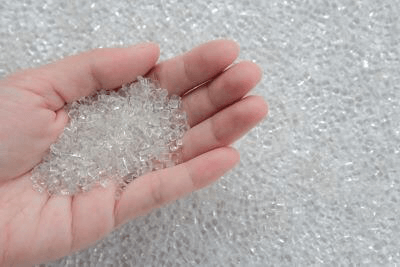What Is a Polyester Resin?

Polyester resin is a generic term for polymers containing ester groups in the main chain. Polyester resins are obtained by the dehydration-condensation of polybasic acids and polyhydric alcohols. A variety of polyester resins with different raw material monomers are sold. A typical example is polyethylene terephthalate (PET), used for beverage containers.
Unsaturated polyesters with unsaturated bonds in the main chain are also used. For example, fiber-reinforced plastic (FRP), a mixture of glass fiber or carbon fiber and resins such as unsaturated polyester, is used as building material, aircraft, and rocket parts.
In addition, biodegradable polyester resins have recently been developed to reduce the burden on the environment, with polylactic acid (PLA) being a typical example. Polylactic acid is a material with low environmental impact because ultraviolet rays and water quickly decompose its main chains, and its waste decomposes in the environment.
Uses of Polyester Resins
Polyester resin is a generic term for polymers that contain ester groups in the main chain. A typical example is polyethylene terephthalate (PET), which has excellent heat and cold resistance and is used for beverage containers. Polyester resin is also used as a fiber. In addition to PET, polybutylene terephthalate (PBT) and polytrimethylene terephthalate (PTT) are also used as polyester fiber.
There are also unsaturated polyester resins that have unsaturated bonds in their molecules. FRP is in various industries, including aircraft and other transportation components, construction materials, sporting goods, and space-related components such as rockets.
Production Process of Polyester Resins
Polyester resin is obtained through a polymerization reaction in which the carboxylic acid COOH and alcohol OH dehydrate and condense to form ester bonds. There are two methods of manufacturing polyester resins: the ester exchange method using dimethyl terephthalate as raw material and the direct polymerization method using terephthalic acid as raw material. The direct polymerization method is generally used today.
Antimony catalysts were, in the past, catalysts for polymerization. Still, there has been a shift to new catalysts that do not use heavy metals, and titanium and germanium catalysts are currently being used. Various companies are still developing new catalysts, such as titanium and germanium.
Polyethylene terephthalate (PET) is a typical polyester. Reactive unsaturated polyester resin is obtained by mixing a polymerizable vinyl monomer with a base polymer obtained by a polymerization reaction of a polybasic acid and polyhydric alcohol through dehydration condensation and radical catalytic polymerization. The properties of the resin vary greatly depending on the chemical structure of the monomer in bisphenol and other monomers.
Stability and Recycling of Polyester Resins
Polyester resins are more stable materials than other resins. For example, polyethylene terephthalate (PET) has excellent heat and chemical resistance. On the other hand, PET has ester bonds, which cause hydrolysis reactions in alkaline aqueous solutions. In addition, under high temperatures and high humidity, it undergoes hydrolysis reaction with neutral water, so its application to PET recycling is being considered.
Polyester resins with biodegradable properties are also being actively developed, with polylactic acid (PLA) being a typical example. UV light and water accelerate the hydrolysis of the main polylactic acid chain, resulting in a rapid decrease in molecular weight. Therefore, it can be disassembled and remolded after use, decomposing its waste without leaving any environmental residue.